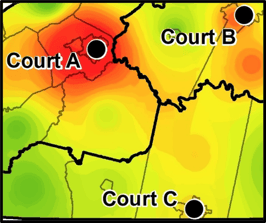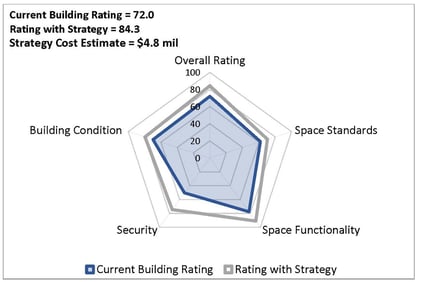I was recently involved in an exciting analysis for a court jurisdiction with multiple courthouses spread across a sizable geographic area. Our goal was to consider whether the existing locations were in the right places, with the idea that the court should serve the people – even if that means closing an existing courthouse because the population and employment base have shifted. To this end, in our courthouse planning, we analyzed trends in population, employment, and caseload, and considered which locations would best meet the needs of the court family and the population served by the court.
In my experience, it takes a brave court to ask such questions. In many jurisdictions, there are heated debates about whether courthouses, often historic, should be kept downtown or whether they should relocate to growing suburban communities. Such debates frequently come down to the influence of a politician or a referendum vote by the citizens to decide on the future location of the court.
This article describes portions of the analysis we conducted with an emphasis on some of the techniques that yielded recommendations to close a court location. One of our primary goals was to remove politics from the equation (for now) and to take a hard look – an objective look – at evolving trends, letting the analysis guide the recommendations. Below is an introduction to three of the analytical methods used in the study.
Hotspot Analysis - in the court stakeholder meetings, we heard comments such as “The population has moved elsewhere” and “The industries that were once here are now gone.” The first step in our process was to gather data to research these assertions and to conduct a hotspot analysis of current and future trends.
Needs Analysis – if a court location was to be closed, could the workload, personnel, and operations be absorbed by another courthouse? To determine this, we performed a needs analysis to assess whether operations in one courthouse could be expanded to accommodate the impact of a closure in another location.
Risk Analysis – it is always a delicate matter to discuss potential courthouse closures. To help in this discussion, a risk analysis was performed to identify the potential risk and mitigation strategies associated with the closures.
A summary of these three analyses are presented below, highlighting how they helped lead to the recommendation for court closure.
Hotspot Analysis
Our first step was to consolidate the population, employment, and caseload trends into an analysis that revealed the current centers of activity in the jurisdiction and how they align with existing courthouses. We call these centers “hotspots.” Imagine a weather map with green indicating no rain and red indicating storms. That is essentially what the hotspot analysis looks like – the green indicates the “cold spots” with little activity, while red represents the most active locations in the jurisdiction. See the example image below, in which Court A is a hub of activity.

Next, we analyzed how the trends in population, employment, and caseload would likely evolve over time, including where hotspots would intensify or cool down.
It was clear from the analysis that one court location was not aligned (and had not been for many years) with the growth in the jurisdiction. The next step was to analyze whether another courthouse could absorb the closure of that “misaligned” courthouse.
Needs Analysis
The goal of the needs analysis in this case was to evaluate whether the workload and personnel from a closed courthouse could be absorbed by another courthouse in a strategic location. We had to determine whether the other courthouse had sufficient space to accommodate the associated increase in workload, personnel, and operational needs. To do this, we developed an implementation strategy that considered the changes that needed to be made to both improve the existing courthouse and to accommodate the additional demand. Examples of projects in an implementation strategy could include additional courtrooms, chambers, clerk’s office space, elevators, jury facilities, or a larger prisoner holding area. Once we had identified the implementation strategy, we calculated a benchmark cost for the strategy to provide the court and other stakeholders with an estimate of the funding needed.
Our next step was to use a set of performance measures to rate the existing facility “as is” and to also rate its “to be” state (i.e., after implementation of the recommended strategy). To perform this analysis, performance measures were used to calculate a rating for the existing courthouse. In this case, the existing building scored 72 points out of 100, with 100 representing an ideal courthouse. The same performance measures were then applied to the building WITH the improvement strategy incorporated. In this case, by implementing the strategy, the building could increase its rating from a 72.0 to 84.3.
The following image displays what we call a “spidergram,” which illustrates these scores and shows how well the existing courthouse performs today, and how well the courthouse could perform in the future if changes could be made to accommodate the additional operations of the closed courthouse.

In the graphic above, the blue area in the spidergram represents the ratings associated with the existing courthouse. There is an overall rating and a rating for each of the criteria in the performance measurement system. These criteria include:
Space Standards - determines whether the building meets approved space standards
Space Functionality - measures how well court and related operations function and flow in the building
Security - examines the security features of the facility, including prisoner management
Building Condition - evaluates the condition of the space and systems in the building
The thick gray line on the spidergram represents how much the scores for the building could be expected to change after executing the implementation strategy. Due to limitations in the current facility, an ideal score of 100 could not be reached, but the facility could be improved from an adequate courthouse (scoring between 70 and 79) to a well-functioning courthouse (scoring above 80).
A cost estimate totaling $4.8 million was then calculated for the implementation strategy. This is the cost it would take to improve conditions in the facility and to build out space to absorb activities from the closed courthouse.
Risk Analysis
When considering whether to close a court facility, there are many types of risk. Some impact the community while others impact the facility and its operations. A sample of the risk factors we considered are presented below:
- loss of key court personnel
- increased juror and public travel
- increased incidences of “failure to appear”
- changes in jail space needs
- cultural differences among court locations
- economic impact on the closed courthouse community
- lack of funding for moves and space build-outs
We asked stakeholders to rate the probability each risk would occur and the impact the risk would have on the community, court operations, and/or facilities. Some of the greatest concerns centered on jury travel times and distances, and the potential lack of funding for the implementation strategy. Surprisingly, the stakeholders also indicated that there are current risks and expenses in keeping the less active court location open. They discussed staff travel, information technology needs and expenses, the cost of maintaining the facilities, etc.
The risks were quantified, scored, and placed on a heat map. Mitigation strategies were developed for risks that had both a high probability and a large impact on the court.
Findings
The study resulted in the recommendation for the closure of a court facility. While it is never easy to close a courthouse, the population for this particular court had migrated away over many years and had expanded into other parts of the jurisdiction. The analytical approach provided a solid justification for why the court should be closed. The court understands that there is still a long political process ahead. For that reason, the court was very concerned about the public and, as a mitigation strategy, decided to slowly reduce services so that the impact would be gradual. In doing so, both the personnel that work in the courthouse and the community could adapt over time.
The techniques used in this study can provide guidance to other jurisdictions that are considering similar closures. The newspaper headlines and politics can really challenge a courthouse closure, even with such an analysis. However, the analysis helps shed light on a complex problem, removes much of the subjectivity from the decision-making process, and provides a solid justification for the final decision. I believe this type of analysis is the most responsible thing to do when considering such far-reaching and important decisions as a court closure.





.jpg)
.jpg)
.jpg)
.jpg)
.jpg)
-1.jpg)
.jpg)
.jpg)

